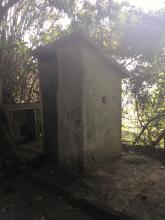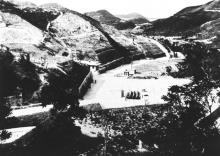Crown Wine Cellars, site of former 'Central Ordinance (Munitions) Depot, Little Hong Kong' [????- ]
Primary tabs
According to their website, 'Crown Wine Cellars is acknowledged as one of the world’s finest wine cellar facilities'. It continues: "The original structures were constructed almost 70 years ago by the British Military to serve as an ammunition and weapons storage depot in preparation for World War II. The site was originally known as the Central Ordnance (Munitions) Depot, and included 24 underground Bunkers, of which only 8 remain."
Their website also gives several pages of history about the Depot in the time up to and during the Japanese invasion in WWII. The Depot is also mentioned several times in Tony Banham's 'Not the slightest chance'. The final mention is in chapter 8, 'The week immediately following the fighting':
On Saturday the 27th, the Japanese flag is raised in Central. However, they are still not fully in control of the island. Lewis Bush HKRNVR, a fluent Japanese speaker with a Japanese wife, is sent at the request of the Japanese to the Little Hong Kong ordnance depot near Aberdeen, where some Royal Engineers are still refusing to surrender. Eventually they emerge and the Japanese take them to Aberdeen, treating them as heroes (95-163).





Comments
A few details
Hi David,
Thought I would add in a few nifty details that you might have forgotten/not known about.
Pre-War- I believe it was completed in 1937, as an extremely well kept secret. The location of the Central Ordinance Muntions Depot was classified and kept a tight secret by the Commonwealth military in HK. It was nicknamed by them 'Little Hong Kong' to confuse possible Japanese spies with Aberdeen (cantonese name: Little Hong Kong).
In Conflict: Originally, the defence was manned by members of the Winnipeg Grenadiers. But after the Battle of Wong Nai Chung gap, troops were needed for a counterattack. Royal Navy sailors took over the defence of the depot to free up this Winnipeg Grenadiers company, who were involved in an unsuccessful counterattack on the gap. (HKVDC war diary)
By Dec. 27th: As mentioned in 'Not the slightest chance,' this was infact the last holdout to surrender to the Japanese. On Dec, 27th. However, at this time, it was not only manned by Royal Engineers, but also members of; The Royal Army Service Corps, Royal Army Ordanance Corps, 5 Winnipeg grenadiers, 14 uniformed Chinese HKVDC soldiers, 18 soldiers from the Middlesex Regiment and a couple Punjabi infantrymen.
-(COOL BIT)- IJN Captain Suzuki was sent by General Sakai to asses the situation and try to negotiate with the troops there. Upon realising that the commanding officer Major Dewar had wired up all the 24 bunkers to a central detonator and that the depot was almost impervious to attack, he attempted to negotiate a surrender. An honorable surrender was agreed upon.
-As said in 'Not the slightest chance,' these troops were brought down to Aberdeen by the Japanese and 'treated like heroes.' (According to British/Japanese Army Interpreuter Lewis Bush)- The men were treated 'like heroes' and given 'whisky and beer aplenty.'
-During the occupation it is suspected the Japanese built the current gaurdhouse, visible from the front.
Crown Wine Cellars
Although I am not a member of the Crown Wine Cellars, I have visited many times and am friendly with Greg De'eb who is, (I believe), the Manager there. (I do hope I have not "demoted" him regarding his title)!
Many moons ago I presented to the Club a few pages from the official Hong Kong Police War Diary 1941, which refer to the Munitions Depot. The part which I presented covers the operation led by Asst. Supt. George Wright-Nooth, author of "Prisoner of the Turnipheads," on the Depot to collect grenades and other munitions to distribute to the fighting troops.
Wright-Nooth mentions this raid in his book, describing how he came under Japanese fire throughout - and also how he had to request volunteers from the European police contingent as the locals were none too keen on the idea.
Wright-Nooth later received a commendation for his actions; I should imagine whilst in captivity in Stanley Camp.
I have my own fond memories of the Depot - in the 1970's it served as the Police Driving School for the Royal Hong Kong Police. Some of the buildings were pulled down for private housing, and I think the Government quarters called Glendale.
Re: Munitions Depot at Shouson Hill
The Munitions Depot and a certain Major Dewar (mentioned elsewhere on Gwulo) are mentioned in an article about Christmas 1941, 20 years later. In the page finder, scroll to Page 24 of the China Mail dated 16 December 1961.